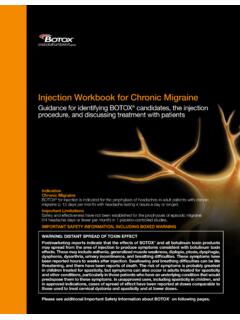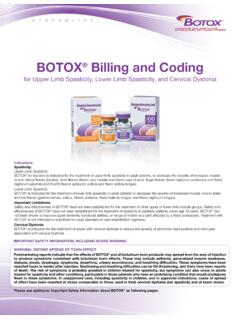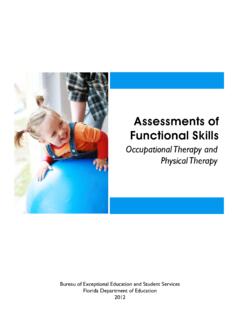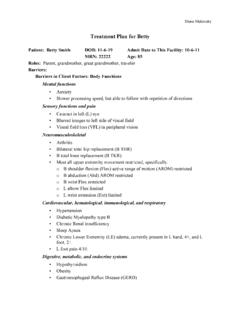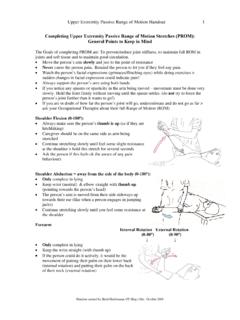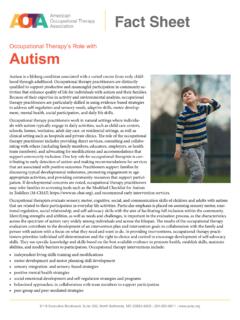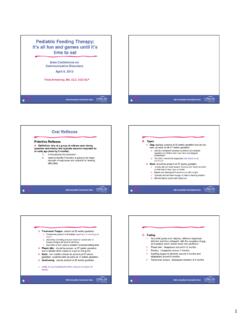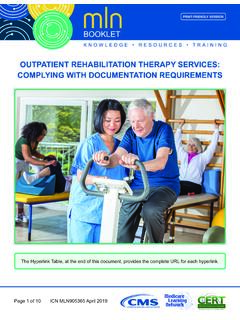Transcription of Injection Workbook for Focal Spasticity
1 Injection Workbook forFocal SpasticityIdentifying Patients, Advanced Anatomy,and the BOTOX Treatment FrameworkWARNING: DISTANT SPREAD OF TOXIN EFFECTP ostmarketing reports indicate that the effects of BOTOX and all botulinum toxin products may spread from the area of Injection to produce symptoms consistent with botulinum toxin effects. These may include asthenia, generalized muscle weakness, diplopia, ptosis, dysphagia, dysphonia, dysarthria, urinary incontinence, and breathing difficulties. These symptoms have been reported hours to weeks after Injection . Swallowing and breathing difficulties can be life threatening, and there have been reports of death. The risk of symptoms is probably greatest in children treated for Spasticity , but symptoms can also occur in adults treated for Spasticity and other conditions, particularly in those patients who have an underlying condition that would predispose them to these symptoms.
2 In unapproved uses, including Spasticity in children, and in approved indications, cases of spread of effect have been reported at doses comparable to those used to treat cervical dystonia and Spasticity and at lower doses. IndicationsSpasticity:Upper Limb SpasticityBOTOX for Injection is indicated for the treatment of upper limb Spasticity in adult patients to decrease the severity of increased muscle tone in elbow, wrist, finger, and thumb flexors (biceps, flexor carpi radialis, flexor carpi ulnaris, flexor digitorum profundus, flexor digitorum sublimis, adductor pollicis, and flexor pollicis longus).Lower Limb SpasticityBOTOX is indicated for the treatment of lower limb Spasticity in adult patients to decrease the severity of increased muscle tone in ankle and toe flexors (gastrocnemius, soleus, tibialis posterior, flexor hallucis longus, and flexor digitorum longus).
3 Important LimitationsSafety and effectiveness of BOTOX have not been established for the treatment of other upper or lower limb muscle groups or for the treatment of Spasticity in pediatric patients under age 18 years. BOTOX has not been shown to improve upper extremity functional abilities, or range of motion at a joint affected by a fixed contracture. Treatment with BOTOX is not intended to substitute for usual standard of care rehabilitation SAFETY INFORMATION, INCLUDING BOXED WARNINGP lease see additional Important Safety Information about BOTOX course is designed to help hone your skills in identifying Focal Spasticity patients who may be BOTOX candidates and implementing the BOTOX Treatment Framework. We ll also discuss the resources and services offered by Allergan as part of our commitment to support your SAFETY INFORMATION (continued)CONTRAINDICATIONSBOTOX is contraindicated in the presence of infection at the proposed Injection site(s) and in individuals with known hypersensitivity to any botulinum toxin preparation or to any of the components in the see additional Important Safety Information about BOTOX on following of contentsIdentifying BOTOX candidatesAdvanced diagnosis.
4 4 Patient assessment ..8 Injecting BOTOX patientsThe BOTOX Treatment Framework ..10 The right goals ..12 The right muscles/dose ..14 The right plan ..44 Sample BOTOX Treatment Framework documentation ..46 Dilution, reconstitution, and Injection ..52 Preparing your practiceAllergan resources and support ..5654 Advanced diagnosisPrevalence of common Spasticity causes1 Patient considerationsPresentation is similar across conditions, but it s important to consider additional factorsIMPORTANT SAFETY INFORMATION (continued)WARNINGS AND PRECAUTIONSLack of Interchangeability Between Botulinum Toxin ProductsThe potency Units of BOTOX are specific to the preparation and assay method utilized. They are not interchangeable with other preparations of botulinum toxin products and, therefore, units of biological activity of BOTOX cannot be compared to nor converted into units of any other botulinum toxin products assessed with any other specific assay see additional Important Safety Information about BOTOX on following pages.
5 Traumatic Brain Injury423% Spinal Cord Injury565% Adult Cerebral Palsy673% Multiple Sclerosis384% Stroke2(N = 504)(N = 23,795)(N = 20,969)(N = 338)(N = 354)58%Most Common Causes of Spasticity5 Conditions like adult cerebral palsy can result in balance difficulties7 Behavioral/cognitive issues can stem from traumatic brain injuries8 Traumatic events like a stroke can cause muscle stiffness/tightness, which can interfere with treatment goals2 Spasticity can present intermittently in chronic conditions, such as multiple sclerosis9 Advanced diagnosis76 Advanced diagnosisIMPORTANT SAFETY INFORMATION (continued)WARNINGS AND PRECAUTIONS (continued)Spread of Toxin EffectSee Boxed see additional Important Safety Information about BOTOX on following can worsen over timeIn separate studies of post-stroke symptoms can manifest in generalized and regional spasticity12 STROKEMONTH1 MONTH2 MONTH3 MONTH4 MONTH5 MONTH627%of post-stroke patients have signs of Spasticity within 6 weeks (N = 86)10 STROKEMONTH1 MONTH2 MONTH3 MONTH4 MONTH5 MONTH652%of post-stroke patients present with contracture within 6 months in at least 1 joint (N = 165)
6 11 GeneralizedIncreased muscle tightness/tonality that affects widespread portions of the bodyTypes of spasticityThere are 3 types of Spasticity , based on how much of the body is affectedRegionalAffects motor skills over a large region of thebody, such as the torso or entire left sideFocalMuscle tightness/tonality that affects 1 or morebody parts in an isolated area, which can adversely affect the patientNotesAdvanced diagnosisBOTOX has not been shown to improve upper extremity functional abilities, range of motion at a joint affected by a fixed contracture, or prevent disease assessmentIMPORTANT SAFETY INFORMATION (continued)WARNINGS AND PRECAUTIONS (continued)Serious Adverse Reactions With Unapproved UseSerious adverse reactions, including excessive weakness, dysphagia, and aspiration pneumonia, with some adverse reactions associated with fatal outcomes, have been reported in patients who received BOTOX injections for unapproved uses.
7 In these cases, the adverse reactions were not necessarily related to distant spread of toxin, but may have resulted from the administration of BOTOX to the site of Injection and/or adjacent structures. In several of the cases, patients had pre-existing dysphagia or other significant disabilities. There is insufficient information to identify factors associated with an increased risk for adverse reactions associated with the unapproved uses of BOTOX . The safety and effectiveness of BOTOX for unapproved uses have not been see additional Important Safety Information about BOTOX on following assessmentMultiple approaches may be useful when assessing Focal SpasticityConsider using mild/moderate/severe framework when capturing observationsIt may be time to revisit these patients treatment plansDo you have Focal Spasticity patients in your practice on muscle relaxants and only call in for refills?
8 Are meeting treatment goals on current therapy?Do not follow their treatment regimen?Have finished PT/OT sessions, but want to continue working on symptoms?PT/OTAre contraindicated to certain treatment options?Diagnosis TechniqueObservationsAsk the patient what has impacted post-stroke treatment goals Muscle tightness and stiffness are usually mentioned the mostAsk the patient if they have ever taken muscle relaxantsMay indicate if another physician had noticed the spasticityHave the patient stand upHelps determine the effect of symptoms on balance and exposes the patient s limbsShake the patient s handPatient must extend 1 arm, allowing you to check for signs and symptoms in both limbsHave patient raise their arms above their head and/or straight outAllows you to quickly look for effects of Spasticity on elbow, wrist, and fingersAmbulatory PatientsNonambulatory Patients* Evaluate all affected joints of ankle and toe in all positions.
9 Supine, seated, standing, and moving Observe and evaluate patient s gait, including gait cycle, as part of determining severity Measure the time it takes for patient to walk a set distance or get up from seated position and walk to a set point Look for potential skin breakdown caused by Spasticity Compare positioning when sitting vs lying down Determine if patient s leg position impedes transfersLower limb spasticityUpper limb Spasticity *Nonambulatory patients were excluded from the BOTOX lower limb Spasticity clinical Treatment FrameworkFor each Focal Spasticity patient, Treatment Framework OverviewIMPORTANT SAFETY INFORMATION (continued)WARNINGS AND PRECAUTIONS (continued)Hypersensitivity ReactionsSerious and/or immediate hypersensitivity reactions have been reported. These reactions include anaphylaxis, serum sickness, urticaria, soft-tissue edema, and dyspnea.
10 If such a reaction occurs, further Injection of BOTOX should be discontinued and appropriate medical therapy immediately instituted. One fatal case of anaphylaxis has been reported in which lidocaine was used as the diluent, and consequently the causal agent cannot be reliably see additional Important Safety Information about BOTOX on following Treatment FrameworkThe right goalsThe right muscles/doseThe right planEstablish specific and realistic goals to guide the course of careDevise a plan to re-evaluateBOTOX performance throughout treatment sessionsUse goals and postures to identify optimal muscle selection/BOTOX doseEstablish specific and realistic goals to help guide the course of care Determine how BOTOX fits into the overall treatment plan to help achieve these goals When using BOTOX , it s important to set expectations to help ensure the patient follows the treatment planUse patient goals and presenting postures/symptoms to help optimize muscle selection and select the appropriate BOTOX dose Identify muscles contributing to the posture(s)


